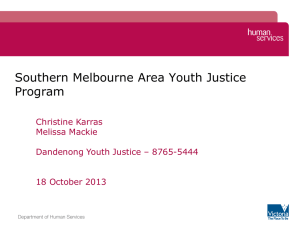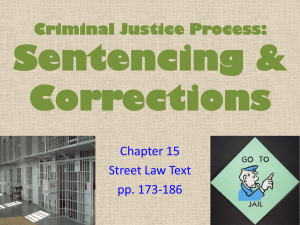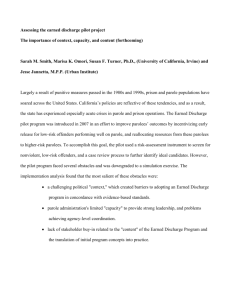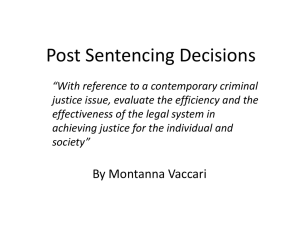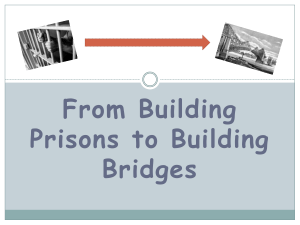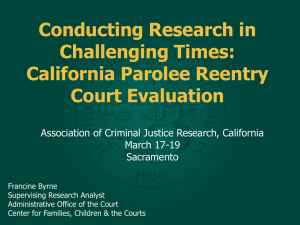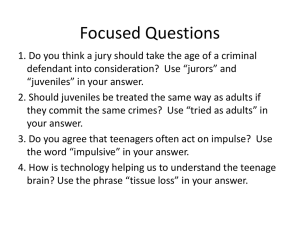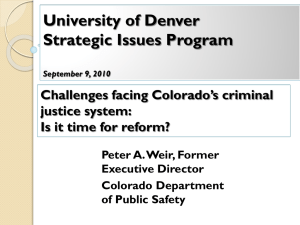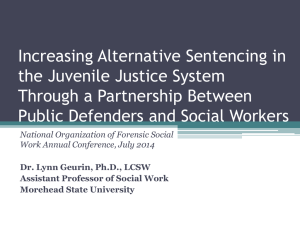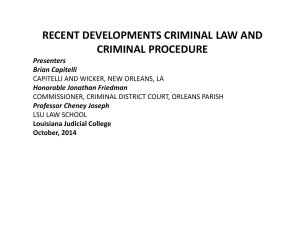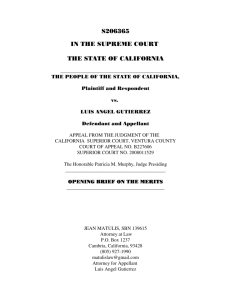The Case for JLWOP Reform
advertisement
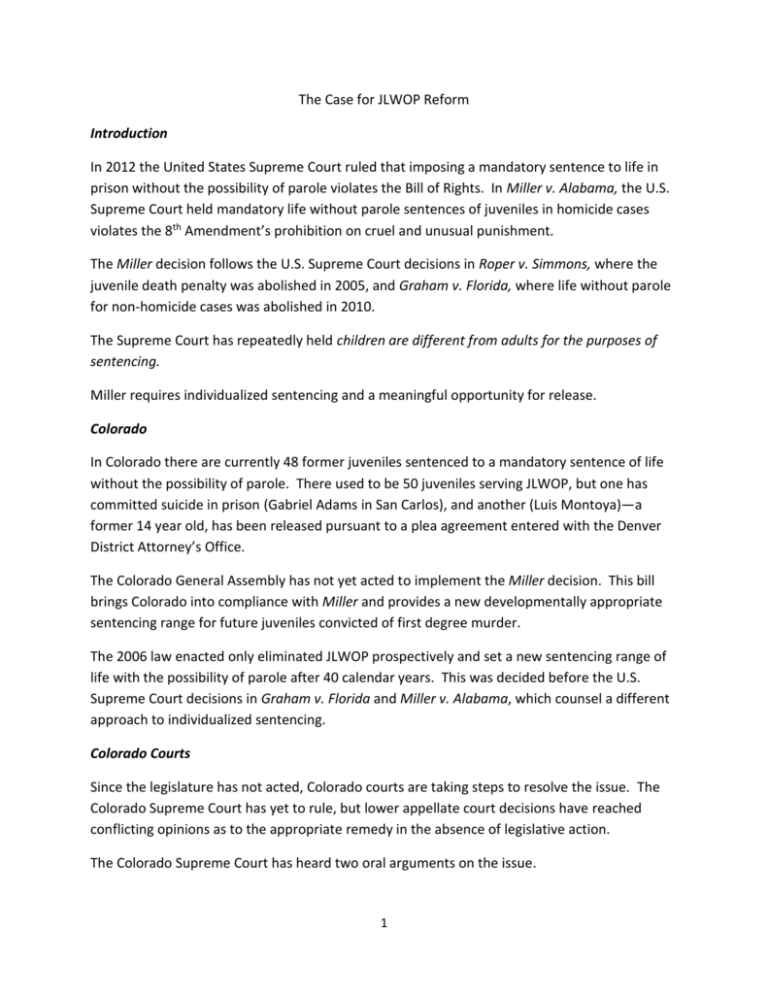
The Case for JLWOP Reform Introduction In 2012 the United States Supreme Court ruled that imposing a mandatory sentence to life in prison without the possibility of parole violates the Bill of Rights. In Miller v. Alabama, the U.S. Supreme Court held mandatory life without parole sentences of juveniles in homicide cases violates the 8th Amendment’s prohibition on cruel and unusual punishment. The Miller decision follows the U.S. Supreme Court decisions in Roper v. Simmons, where the juvenile death penalty was abolished in 2005, and Graham v. Florida, where life without parole for non-homicide cases was abolished in 2010. The Supreme Court has repeatedly held children are different from adults for the purposes of sentencing. Miller requires individualized sentencing and a meaningful opportunity for release. Colorado In Colorado there are currently 48 former juveniles sentenced to a mandatory sentence of life without the possibility of parole. There used to be 50 juveniles serving JLWOP, but one has committed suicide in prison (Gabriel Adams in San Carlos), and another (Luis Montoya)—a former 14 year old, has been released pursuant to a plea agreement entered with the Denver District Attorney’s Office. The Colorado General Assembly has not yet acted to implement the Miller decision. This bill brings Colorado into compliance with Miller and provides a new developmentally appropriate sentencing range for future juveniles convicted of first degree murder. The 2006 law enacted only eliminated JLWOP prospectively and set a new sentencing range of life with the possibility of parole after 40 calendar years. This was decided before the U.S. Supreme Court decisions in Graham v. Florida and Miller v. Alabama, which counsel a different approach to individualized sentencing. Colorado Courts Since the legislature has not acted, Colorado courts are taking steps to resolve the issue. The Colorado Supreme Court has yet to rule, but lower appellate court decisions have reached conflicting opinions as to the appropriate remedy in the absence of legislative action. The Colorado Supreme Court has heard two oral arguments on the issue. 1 What the Bill Does This bill provides a new sentencing range for juveniles convicted of first degree murder for offenses that occur after July 1, 2015, and for the juveniles currently serving life without parole. Thus, the bill provides a path for Miller compliance that is consistent with future cases. What the Bill Does Not Do The bill does not affect juveniles sentenced to life imprisonment with the possibility of parole after forty calendar years for crimes committed between July 1, 2006 and July 1, 2015. While a mandatory life imprisonment with the possibility of parole after 40 calendar years may violate the 8th Amendment, no court has yet made that ruling. Furthermore, in Colorado the Herrera decision states legislators cannot change a sentence range after it is final. Thus, without a finding that the 40 to life sentence is unconstitutional, the legislature cannot retrospectively change the sentencing range. There is still some relief available to a juvenile serving life with parole after 40 calendar years under C.R.S. 17-22.5-403.7, Parole eligibility for juvenile convicted of class 1 serving 40 to life. The Differences between Current Law and the Bill Current Law Proposed Bill JLWOP Life with parole after 40 calendar years 24 to 48 years in prison, 10 years parole Life with parole after 20 calendar years Mandatory Sentence Judicial Discretion to impose either a lengthy determinate sentence or an indeterminate life sentence Parole is for life SAME: Parole is for life There is no earned time or good time for juveniles convicted of class 1 felonies. There is no earned time for juveniles sentenced to life. There is earned time for juveniles sentenced in the determinate range in future cases but juveniles must serve 75% of their sentence. 2 Anticipated Questions and/or Opposition Statements Did the legislature abolish JLWOP in 2006 and replace it with life with parole eligibility after 40? Only prospectively. The 2006 law was enacted before Graham v. Florida and Miler v. Alabama. Is Miller retroactive? The Colorado Attorney General has argued a “fair and just result” requires Miller be applied retroactively. The United States Attorney General’s office agrees Miller is retroactive. The U.S. Supreme Court was about to hear a case to decide whether Miller was retroactive but the US Attorney General agreed to plea agreement that mooted the case. Five cases are being considered by court 3/20/15. The majority of states have ruled Miller IS retroactive: Illinois, Iowa, Massachusetts, Mississippi, Nebraska, New Hampshire, South Carolina, Texas, Wyoming, Florida (10 states), and California intermediate court Not retroactive states: Louisiana, Michigan, Minnesota, Pennsylvania (4 states), and Alabama intermediate court The majority of federal circuit courts ruled Miller IS retroactive: 5th, 3rd for purposes of filing habeas 1st, 8th, 2nd, accepted prosecutor’s concession Two circuit courts say no (11th, 5th) Are you rushing legislation when the Vigil case was argued two weeks ago? Miller was decided in 2012 and reform is long overdue. It is the legislature’s failure to act, that is leading to inconsistent court decisions. The Colorado also heard oral argument June 4, 2014 in three JLWOP cases and has yet to issue ruling. 3 The Wilder court recognized that “this is an area for legislative action, but pending legislative action, it is incumbent on us to provide our interpretation of the most appropriate remedy to implement Miller. Is this an ex post facto law? There is no ex post facto problem with the Bill, since an ameliorative change to the sentencing scheme, like the one in the Bill, is “incapable of violating the ex post facto clauses.” People v. District Court, 834 P.2d 181, 200 (Colo. 1992) Doesn’t Miller allow for a sentence of life without parole if there is judicial discretion to impose a lesser sentence? Correct. Miller did not categorically ban on life without parole sentencing, though it said such sentences would be rarely justified. However, Colorado already abolished life without the possibility of parole in 2006. Where does the 20 year minimum come from, what is the justification for cutting the minimum in half? Developmental research recommends a look back every 10-15 years, a twenty year term is more than adequate to determine whether a juvenile is rehabilitated Why don’t we just make the 2006 bill that provides an opportunity to parole after 40 calendar years the sentencing range for the JLWOPS. Life with the possibility of parole after 40 calendar years is on the extreme end of sentencing, even for adults convicted of first degree murder. Most states have a minimum sentence in the 20-25 year range. Moreover, more states are looking at even lower sentencing ranges for juveniles convicted of first degree murder. West Virginia created 15 years to life Nevada is considering 15 years to life Why not just impose an indeterminate Colorado’s sentencing laws were created for sentence, why include a determinate range for adults. Since the Supreme Court has found first degree murder? juveniles as a class are categorically less 4 culpable than adult, it makes sense to create a determinate option for the cases that warrant that type of sentence, like felony murder cases where there is no requirement that a juvenile intend to kill or be the actual killer. Why did you select 24 to 48 years? The sentencing range of 24 to 48 years is between first and second degree murder. The range for second degree murder is 16 to 48 years. Under this bill a juvenile convicted of first degree murder could never get a 16 year sentence, so there is a distinction between first and second degree murder. Why didn’t this proposal go through the CCJJ? It is the legislature’s prerogative to Miller was decided in 2012 and the CCJJ, like the state legislature, has made no apparent effort to address it. Courts are moving forward and the time to act is now. They will be immediately eligible for parole? No, everyone has to be resentenced first, and the bill lays out a timetable for parole eligibility Life Sentences in Colorado, C.R.S. 17-22.5-104(2) Before July 1, 1977 Life with parole after 10 calendar years Between July 1, 1977 and before July 1, 1985 Life with parole after 20 calendar years Between July 1, 1985 and before July 1, 1990 Life with parole after 40 calendar years July 1, 1990 to Present (for Adults) Life without the possibility of parole or death July 1, 2006 to Present (for Juveniles) Life with parole after 40 calendar years THIS BILL: 7/1/1990 to 6/30/2006, and starting 7/1/2015 Life with parole after 20 calendar years Determinate sentence of 24 to 48 years 5 Colorado appellate cases to date People v. Wilder 2/26/2015 Court of Appeals -sentence must be vacated -remand for resentencing consistent with Miller Attorney General conceded retroactivity -POWER TO DEFINE CRIMES/SENTENCES VESTED EXCLUSIVELY IN THE LEGISLATURE. THIS IS AN AREA FOR LEGISLATIVE ACTION -disagrees with Banks/Gutierrez-Ruiz severability analysis -adopts the approach in Tate -individualized sentencing using Miller factors -remand for resentencing OPEN, but trial court should consider class 2 sentencing range (1224 years) and effect of extraordinary aggravating factors People v. Gutierrez-Ruiz 2014 Court of Appeals -disagreed with mandatory sentence -individualized determination of whether JLWOP is appropriate Attorney general conceded retroactivity -remand to: (1) individualized determination of JLWOP; (2) if no JLWOP then 40 years People v. Valles 2013 Court of Appeals -followed Banks reasoning BUT Judge Taubman (author of Valles) backtracked in his concurrence on the Wilder case, stating he now believes an individualized sentence is required. AND wrote why Miller is retroactive in the Wilder case. Attorney general conceded retroactivity People v. Banks 2012 Court of Appeals, NOW IN SUPREME COURT -sentence was unconstitutional -only authorized penalty was life with 40 through severability 6 Attorney general conceded retroactivity -affirmed sentence to life, vacated without parole with instructions to modify sentence to include possibility of parole after 40 -severing to 1985 statute, consistent with 2006 People v. Tate 2012 Court of Appeals, NOW IN SUPREME COURT Argued June 4, 2014 –no supreme court decision People v. Jenson SUPREME COURT Argued June 4, 2014—no decision People v. Vigil SUPREME COURT -Local DA (Jeffco) raised retroactivity, two DA’s (Denver, Arapahoe) signed amicus brief -issues are: (1) retroactivity and (2) remedy People v. Wilder & LEGISLATION ¶ 39 We recognize that “[t]he power to define crimes and prescribe punishments is vested exclusively in the legislature,” and the judiciary’s duty is only to impose sentences “within the legislatively mandated limits.” People v. Montgomery, 669 P.2d 1387, 1390 (Colo. 1983). However, given that the part of section 18–1.3401(4)(a) applicable to defendant, who committed a class 1 felony in 1998, is unconstitutional as applied to him, the trial court is, in effect, left with no applicable legislative sentencing guidelines to apply on remand. *8 ¶ 40 We recognize that this is an area for legislative action, but pending legislative action, it is incumbent on us to provide our interpretation of the most appropriate remedy to implement Miller.4 Due to our concerns with the imposition of another mandatory sentencing scheme adopted by the divisions in Banks and Gutierrez–Ruiz, we have determined to adhere to the following approach (also considered by the division in Tate ) and remand to the trial court for an individualized sentencing determination based on the factors elucidated in Miller. 7 Legislative Intent in 2006 (a) Under the existing sentencing laws, a juvenile who is convicted as an adult of a class 1 felony is automatically sentenced to life imprisonment without the possibility of parole, which is the same sentence that applies to an adult who is convicted of a class 1 felony and who does not receive a death sentence; (b) Persons younger than eighteen years of age may commit crimes that are sufficiently serious, violent, or heinous to warrant punishment in the adult correctional system, and it is in the interest of public safety to ensure that a juvenile who commits an adult-level crime receives an appropriately severe degree of punishment in correlation to the level of crime committed; (c) Because of their level of physical and psychological development, juveniles who are convicted as adults may, with appropriate counseling, treatment services, and education, be rehabilitated to a greater extent than may be possible for adults whose physical and psychological development is more complete when they commit the crimes that result in incarceration; (d) A sentence to lifetime imprisonment without the possibility of parole for a juvenile who is convicted as an adult of a class 1 felony condemns the juvenile to a lifetime of incarceration without hope and, in most cases, without education or rehabilitation services, and results in the irredeemable loss of a person to society. (2) The general assembly finds, therefore, that it is not in the best interests of the state to condemn juveniles who commit class 1 felony crimes to a lifetime of incarceration without the possibility of parole. Further, the general assembly finds that it is in the interest of justice to recognize the rehabilitation potential of juveniles who are convicted as adults of class 1 felonies by providing that they are eligible for parole after serving forty calendar years of their sentences. 8
